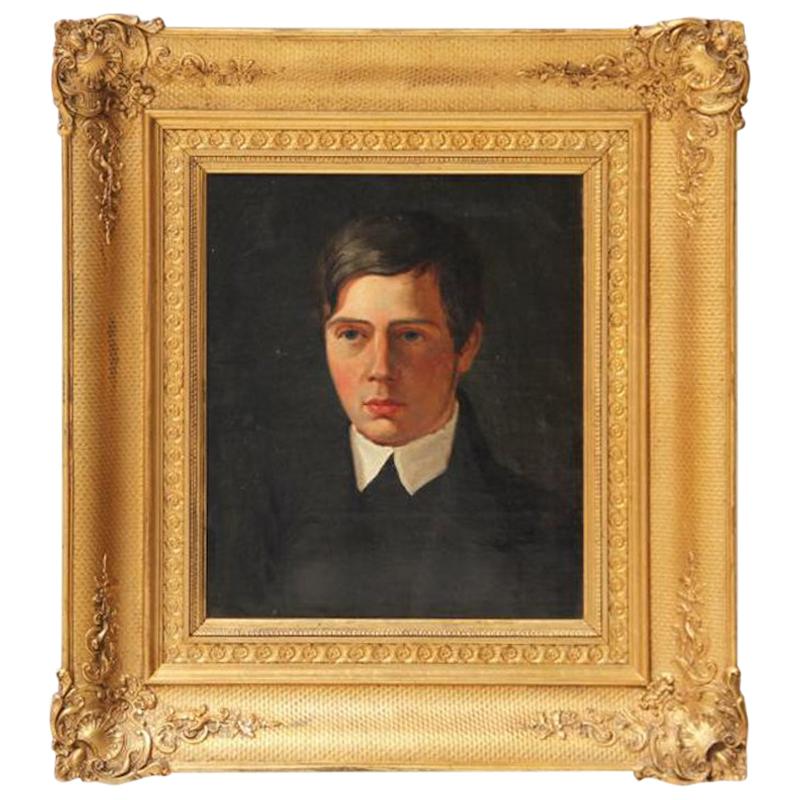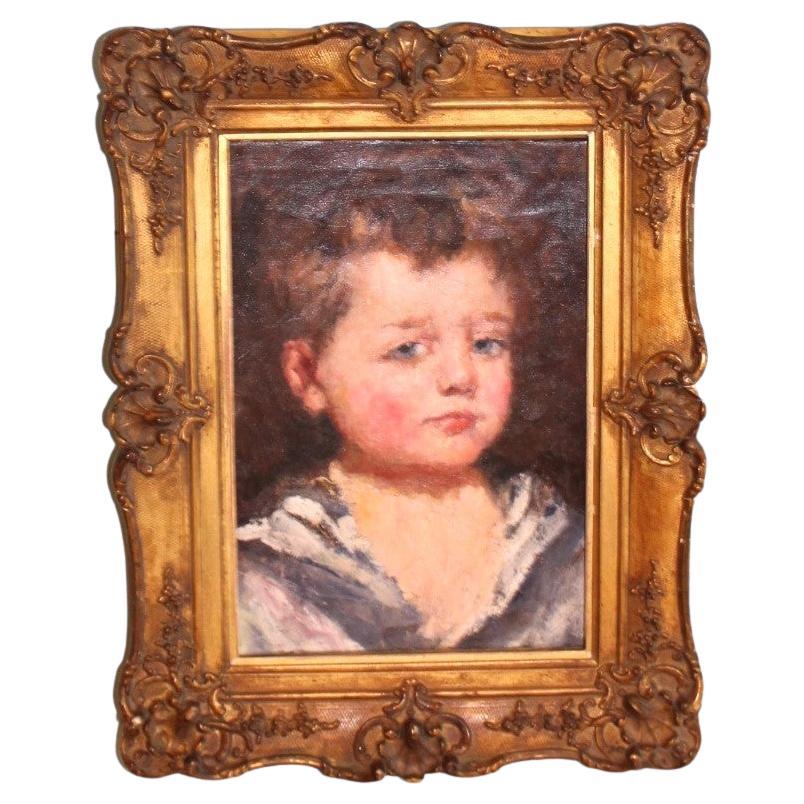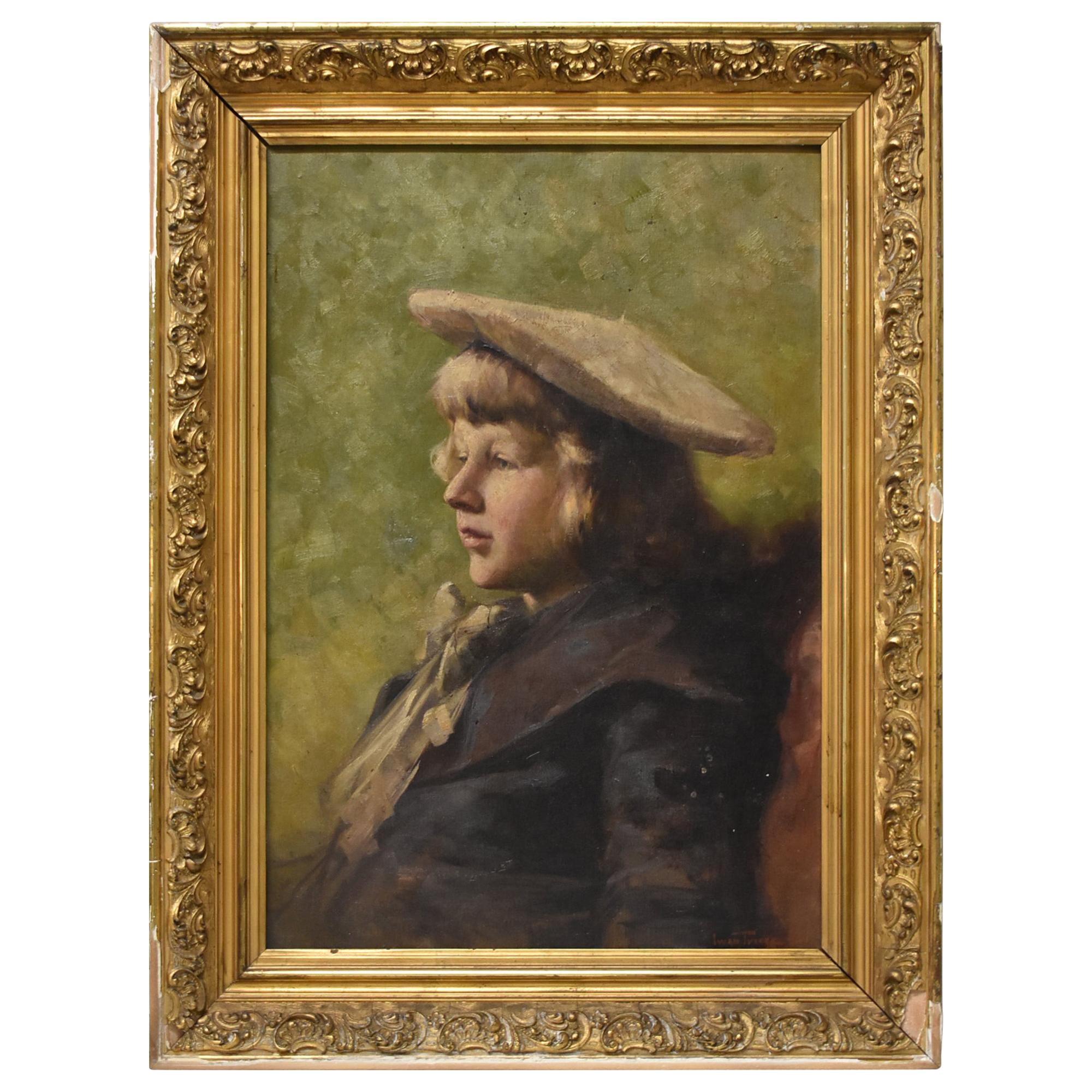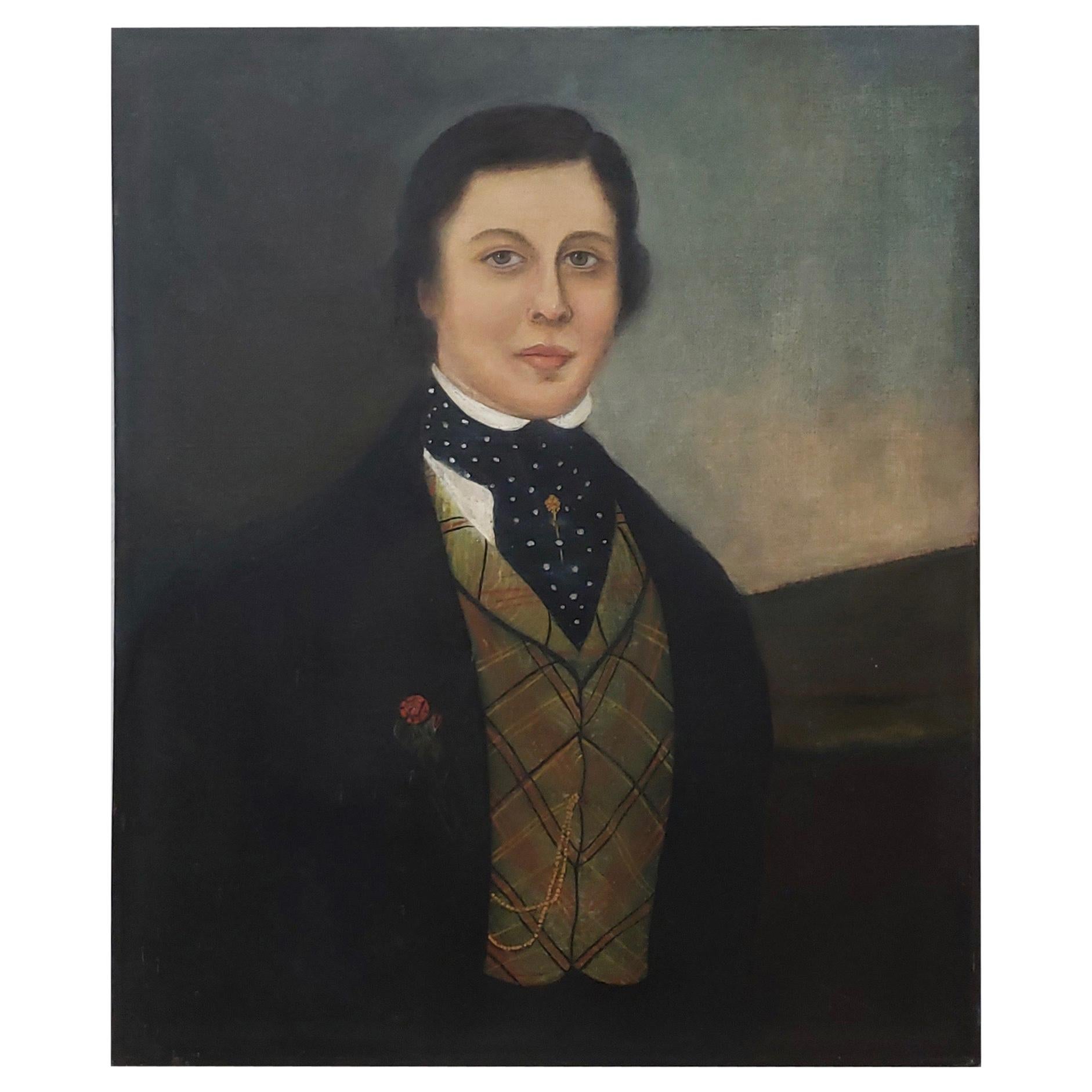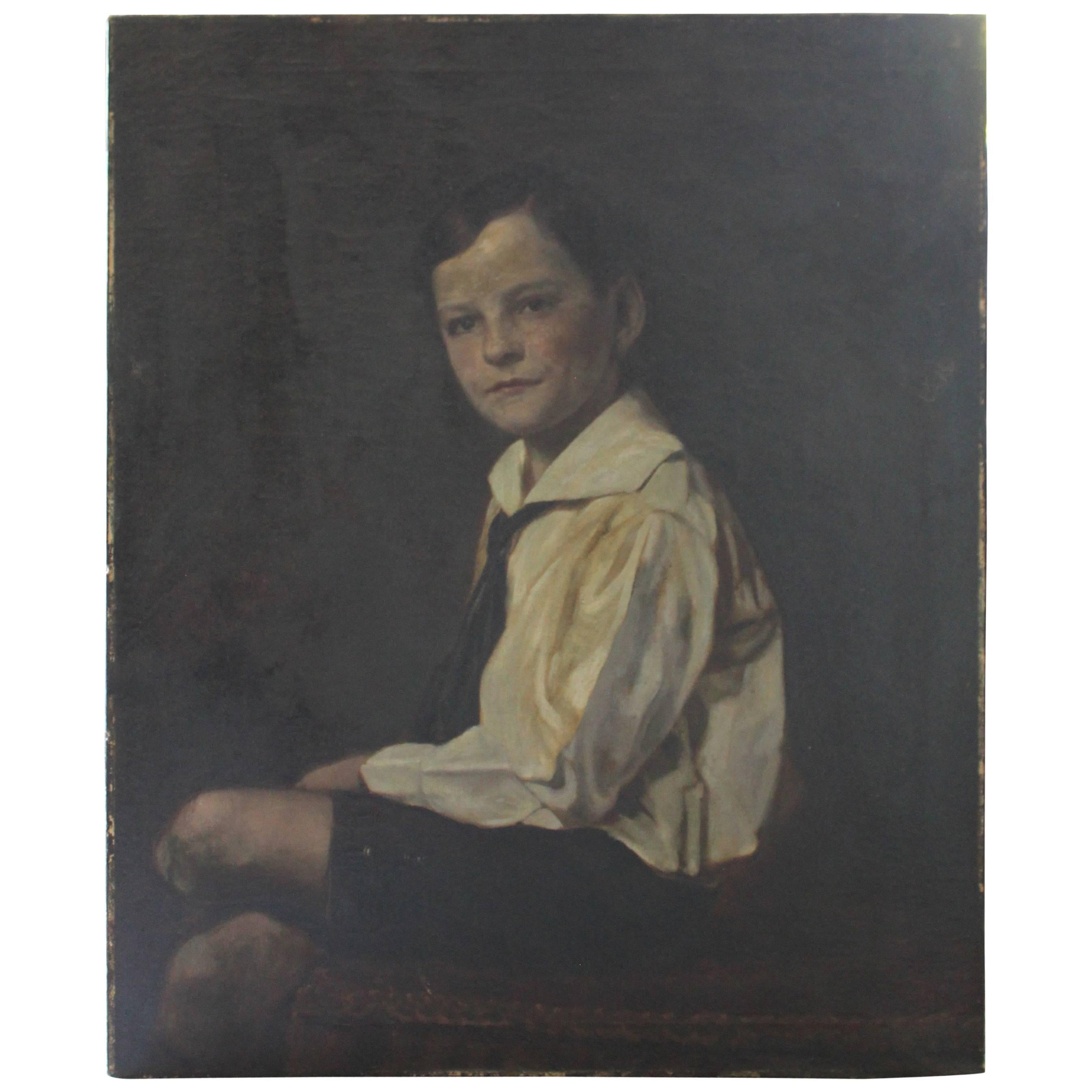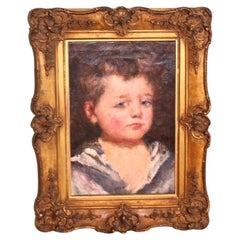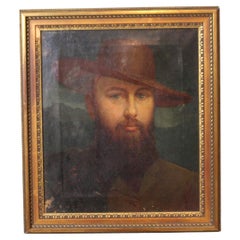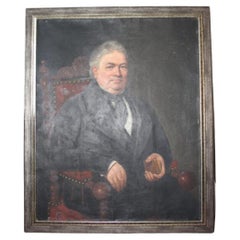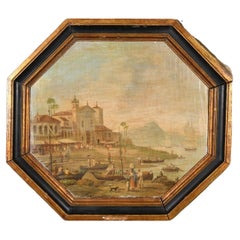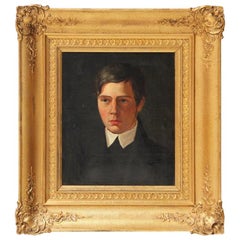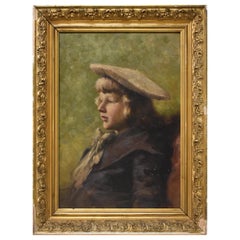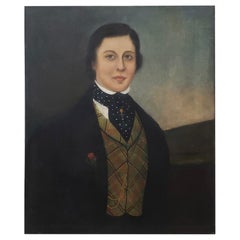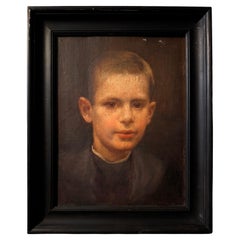Items Similar to Portrait of a Young British Gentleman in China Chinese Export School, circa 1920
Want more images or videos?
Request additional images or videos from the seller
1 of 13
Portrait of a Young British Gentleman in China Chinese Export School, circa 1920
$1,609.42
£1,190
€1,408.88
CA$2,225.17
A$2,492.56
CHF 1,309.18
MX$30,308.76
NOK 16,578.54
SEK 15,737.50
DKK 10,514.99
About the Item
An evocative early 20th-century oil portrait depicting a poised young British gentleman, likely a merchant or naval officer, painted against a moody, clouded sky with a distinct pagoda on the horizon. The sitter is dressed in formal attire with a dark cravat, suggesting upper-middle-class or diplomatic status. His direct, calm gaze and upward tilt of the chin imply self-assurance and ambition—hallmarks of the European elite engaged in colonial-era East Asian trade.
This rare composition is typical of the Chinese Export School or Anglo-Chinese portraiture that flourished in treaty ports like Canton and Hong Kong during the mid-19th century. These hybrid works combined Western likeness with Eastern architectural and maritime motifs, often painted by Chinese artists trained in European technique for foreign patrons.
The finely carved Rococo Revival gilt frame appears original to the painting, adding a rich period presence. The surface shows gentle age-related craquelure, stable condition overall with minor professional retouching expected of a portrait of this age.
Meduim oil on Board
Provannce Chapman Brosthers Chelsea
- Dimensions:Height: 16.93 in (43 cm)Width: 8.67 in (22 cm)Depth: 1.58 in (4 cm)
- Style:Chinese Export (Of the Period)
- Materials and Techniques:
- Period:
- Date of Manufacture:1920s
- Condition:Refinished. Wear consistent with age and use.
- Seller Location:Seaford, GB
- Reference Number:1stDibs: LU10376245005562
About the Seller
New to 1stDibs
Joined in the past six months.
No Reviews Yet
Vetted Professional Seller
Every seller passes strict standards for authenticity and reliability
Established in 2021
1stDibs seller since 2025
Typical response time: 3 hours
- ShippingRetrieving quote...Shipping from: Seaford, United Kingdom
- Return Policy
Authenticity Guarantee
In the unlikely event there’s an issue with an item’s authenticity, contact us within 1 year for a full refund. DetailsMoney-Back Guarantee
If your item is not as described, is damaged in transit, or does not arrive, contact us within 7 days for a full refund. Details24-Hour Cancellation
You have a 24-hour grace period in which to reconsider your purchase, with no questions asked.Vetted Professional Sellers
Our world-class sellers must adhere to strict standards for service and quality, maintaining the integrity of our listings.Price-Match Guarantee
If you find that a seller listed the same item for a lower price elsewhere, we’ll match it.Trusted Global Delivery
Our best-in-class carrier network provides specialized shipping options worldwide, including custom delivery.More From This Seller
View AllAntique Portrait of Young boy Robert Henri
By Robert Henri 1
Located in Seaford, GB
Antique Oil Painting – Studio of Robert Henri – Sailor Boy Mick – Early 20th Century Artwork
Experience the timeless beauty of this Robert Henri Cozad Sailor Boy Mick Oil Painting o...
Category
Vintage 1920s Irish Art Deco Paintings
Materials
Paint
$1,568 Sale Price
20% Off
19th century English school Portrait of Railway Engineer
Located in Seaford, GB
19th-Century Portrait of William Morton, Civil Engineer
Inscribed top left William Morton at 50 1882
Step into history with this exceptional 19th-century portrait of William Morton,...
Category
Antique 19th Century English Victorian Paintings
Materials
Canvas
Antique Large Portrait Of French Bordeaux Gentleman
Located in Seaford, GB
Antique French Gentleman Portrait – 19th/20th Century Oil Painting – Fine Art for Collectors
This is a stunning antique portrait of a distinguished French gentleman, an exquisite 3/...
Category
Antique Late 19th Century French French Provincial Paintings
Materials
Canvas
Early 19th century Capriccio Brazil School Painting
Located in Seaford, GB
Rare Early 19th century Capriccio view of Rio de Janeiro Painting
Probably painted circa 1810 by one of Jean-Baptiste Debret, Italian Students.
Painted on Sailcloth.
Historical Context of Early 19th Century Portuguese Colonial Brazil
1.1 Transition from Colony to Empire
During the early 19th century, Brazil underwent a seismic shift in its political status. Originally a colony under the Portuguese Empire, the arrival of the Portuguese Royal Court in Rio de Janeiro in 1808 rapidly elevated the city’s cultural and political importance. By 1815, Brazil was declared a kingdom united with Portugal, setting the stage for the emergence of the Empire of Brazil in 1822. This period of transformation—often termed the transitional period from colony to empire—fueled a wave of artistic production in cities like Rio de Janeiro.
1.2 European Artistic Influence in Brazil
With the French Artistic Mission in Rio (initiated in 1816) and the presence of various Portuguese and European artists, Brazilian art of the early 1800s began to reflect diverse influences, from neoclassical painting to the early rumblings of romanticism. Painters such as Jean-Baptiste Debret, and Nicolas-Antoine Taunay, and local luminaries like Manuel de Araújo Porto-Alegre contributed to the fine arts tradition in Brazil. Their works featured scenes of local life, portraits of Brazilian society, and imaginative vistas—sometimes referred to as “capriccios,” in which real elements were combined with artistic liberties to create an idealized panorama.
1.3 Rio de Janeiro as Cultural and Political Hub
Rio de Janeiro, often called the Imperial capital after Brazil’s independence, was home to foundational institutions like the Imperial Academy of Fine Arts (Academia Imperial de Belas Artes). Later evolving into the Escola de Belas Artes (School of Fine Arts in Rio), these academies nurtured the talents of emerging painters, who found patronage under the Royal Court and, subsequently, the Imperial Court. The city’s significance was further enhanced by the construction of significant buildings, the modernization of infrastructure, and the mingling of European courtly customs with the traditions of local inhabitants.
. Description of the Octagonal Oil on Canvas: A Capriccio View of Rio de Janeiro
2.1 Composition and Layout
The most striking characteristic of this 19th-century Brazilian art piece is its octagonal shape, a relatively unusual format that draws the viewer’s gaze toward its centre. The composition showcases Rio de Janeiro’s shoreline in the early 1800s, brimming with merchant ships and smaller boats anchored near the shore. On the sand, there is a bustling crowd of local people—men and women carrying food and goods on their heads, loading and unloading boats, and engaging in everyday commerce. The backdrop of soaring mountains suggests Rio’s iconic topography, embodying the landscape that famously defines the city.
2.2 Architectural and Religious Landmarks
On the left side, one can discern the silhouette of a church believed to be Santa Lucia, a significant religious structure in the heart of early 19th-century Rio. This element provides viewers with a tangible reference point, linking the scene to an actual location. However, because this painting is labelled as a “capriccio,” the artist might have taken creative liberties by rearranging or amplifying certain features of the city. The melding of real and idealized elements is characteristic of these imaginative vistas.
2.3 Evoking Daily Life in Colonial Rio
One of the painting’s greatest appeals lies in its portrayal of daily life during the colonial era. Men and women from various backgrounds populate the scene. Some appear to be carrying goods on their heads, a common practice in Brazil that has persisted through different centuries. Others appear to be haggling or trading near small vessels, revealing the commercial pulse of an active port city. This focus on local people, combined with the grandeur of merchant ships, captures the tension and synergy between the every day and the extraordinary—a hallmark of Brazilian colonial painting that balances the grand narratives of empire with the rhythms of ordinary life.
2.4 An Amalgamation of Neoclassical and Romantic Influences
Although academic art in early 19th century Brazil was highly influenced by neoclassicism, the onset of romanticism can be spotted in the emotional portrayal of the sky, the lively palette, and the dramatic emphasis on nature’s beauty (the mountains, in particular). This duality reflects the fine arts tradition in Brazil during the transitional phase when artists were embracing multiple styles. As part of the School of Rio or the Rio de Janeiro school, painters often integrated academic techniques learned from European masters with emerging local subjects and influences.
3. Institutions and Artistic Movements
3.1 Imperial Academy of Fine Arts
Originally known as the Royal School of Sciences, Arts, and Crafts, the Imperial Academy of Fine Arts in Rio de Janeiro was instrumental in shaping 19th-century Brazilian art. Influential artists and teachers from Portugal, France, and other European nations congregated at the Academy, imparting their expertise to native students. As the monarchy consolidated power, the Academy enjoyed royal patronage, leading to the creation of Imperial Academy-style works that combined European academic rigour with Brazilian-themed subject matter.
3.2 Impact of the French Artistic Mission
The French Artistic Mission, which arrived in 1816, played a pivotal role in introducing advanced European artistic techniques, thereby elevating the overall quality of painting in Brazil. Artists like Jean-Baptiste Debret not only documented Brazilian society but also spearheaded the development of a local visual identity that aligned with both academicism and the national context of a blossoming empire. Debret, alongside others such as Nicolas-Antoine Taunay, mentored Brazilian artists, sowing the seeds of what would become the Brazilian academic art movement.
3.3 Religious, Historical, and Landscape Paintings
In addition to everyday scenes and historical compositions, religious iconography remained crucial throughout Portuguese colonial and imperial Brazil. Churches were omnipresent in cityscapes like Rio de Janeiro. Many colonial-era Brazilian portraits...
Category
Antique Early 19th Century Brazilian Spanish Colonial Paintings
Materials
Canvas
$2,921 Sale Price
20% Off
Exquisite 19th Century English Still Life of wild flowers– Oil on Wood Panel
Located in Seaford, GB
A captivating and finely executed 19th-century English still life painting, rendered in oil on wood panel, depicting an abundant bouquet of mixed flowers in a terracotta urn. This hi...
Category
Antique 19th Century English High Victorian Paintings
Materials
Paint
Early 19th century horse painting
By Dean Wolstenholme
Located in Seaford, GB
A Timeless Depiction of the English Fox Hunt
The early 19th-century fox hunting scene, attributed to Dean Wolstenholme Elder, is a stunning representation of the aristocratic traditi...
Category
Antique 1810s English Regency Paintings
Materials
Canvas
You May Also Like
Portrait of a Young Man, Danish School, Late 19th Century
Located in CA, CA
A beautifully painted portrait of a handsome young man from the Danish modern school dating from the late 19th century, in a carved gold frame from the same period.
The painting is ...
Category
Antique Late 19th Century Danish Late Victorian Paintings
Materials
Paint
Oil Portrait Young Man on Canvas by Artist Iwan Tusz
Located in Toledo, OH
Oil on canvas of a young man by Ukrainian artist Iwan Tusz 1869-1941. Has had a small repair. Frame has some damage. Image size measures 15.57" W x 22.25" H, Overall Dimensions: 2" d...
Category
20th Century European Victorian Paintings
Materials
Canvas
Early 19th Century Oil Portrait of a Handsome Young Man
Located in San Francisco, CA
Early 19th century oil portrait of a handsome young man
An original painting of a young man wearing his best suit of clothes.
Original oil on ...
Category
Antique Early 19th Century American Paintings
Materials
Canvas
"Dark Blond Boy", Portrait by 19th Century American Painter, Oil on Canvas
Located in Philadelphia, PA
Clearly painted by an American master such as Thomas Eakins in the second half of the nineteenth century, this shadowy portrait of a young blond boy is handsome and affecting. The y...
Category
Antique Late 19th Century American Victorian Paintings
Materials
Paint
Early 20th Century Portrait of a Young Boy
Located in East Hampton, NY
Early 20th century portrait of a young boy. Oil on canvas.
Category
Early 20th Century Paintings
Materials
Canvas
Early 20th Century Oil on Canvas by C Tertiaux, "Boy From Academy", circa 1922
By Celine Melanie Castelain Tertiaux
Located in Banner Elk, NC
Early 20th century oil on canvas by C Tertiaux, "Boy From Academy" in gold gilt frame, circa 1922. This painting has been cleaned and relined.
Mea...
Category
Mid-20th Century French Art Deco Paintings
Materials
Paint
More Ways To Browse
Middle Eastern Dress
Antique Plow
Antique Salt Bowls
Antique Shamrock
Antique Spring Scale
Antique Street Clock
Antique Thai Buddha Statue
Antique Trough Fountains
Antique Water Kettle
Antique Wood Santos Santo
Art Nouveau Room Divider
Art Nouveau Sugar Bowl
Barbara Barry For Baker
Beetle Model
Blue Swedish Chest
Bone Inlay Dresser
Brass Couple Sculpture
Bruksbo Rosewood
